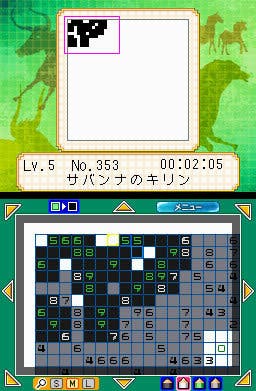Pic Pic
This year's Slitherlink!
For the first few hundred (it's odd to write that) these are quite elementary, only more challenging by their sheer size. Finding that one next move is the aim, which then satisfyingly reveals a stream of new moves. Toward the end, it does slightly disappointingly seem to leave small areas where you're forced to make informed guesses, which seems against the spirit of the thing. But frankly, there's so bloody many - 400 again - you won't mind.
Last, and least least, is Drawing, the deceptively plain name for a completely joyful puzzle - the puzzle that, were Pic Pic to include it alone, would earn the game a 10. It's important to understand this - as many criticisms of Maze Paint or Magipic as I may find to put below, Drawing seals the deal. Everything else is icing.
To communicate how much I love Drawing, let me explain this: there are once more 400 puzzles. I've completed them all twice. Later ones take around 20 minutes to finish. Which if I type into this calculator tells me... I've played this game a lot.
Here you once more have a grid of tiles, again with numbers scattered liberally about them. There's two types, black and white, and colour. We'll start with the former, as they do. Each number has a partner. You have to connect those numbers up, with the number of connecting blocks corresponding to that number. So things begin relatively simply. A 1 is obviously just painted black on its own. 2s are mostly very clear. They're next to each other, and while complicated if grouped together, are obvious enough. 3s get a bit more tricky, as they might be a straight line, or make a right angle. And from then on, it becomes much more tricky. The sight of a 20 on either side of the grid can be daunting. But the pleasure here is, there's never a moment of ludicrous guessing. Like Slitherlink, there's always a correct next move, and it's always enormously rewarding to find it.

But what elevates Drawing above the shoulders of so many entertainingly complex puzzles is the way it so quickly becomes intuitive. You develop instincts so strong that they shift to the right brain, meaning filling in the puzzle can often feel (I'm going to lose so many people here) poetic.
The controls are completely perfect, requiring nothing other than a tap or glide, with no switching back and forth between options (this is one of Magipic's few frustrations - the constant switching between black and white, which can't be assigned to a left-handed button). So faced with a giant screen of numbered tiles, you immediately flick and swoosh your way through the obvious 1s, 2s and 3s, which reveal possible pathways for the higher figures. But here's the most important thing - you can never, ever have an alternative solution. So if you see you're left with two possible routes for a connection to take, and nothing else that's going to change that, you've made a mistake. It's a peculiarly backward thinking - more possibility means an error. And as such, you can apply this rule ahead of time, realising which path you must pick for one string, such that it won't leave variables for those nearby.
